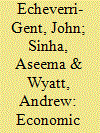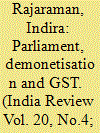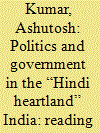|
|
|
Sort Order |
|
|
|
Items / Page
|
|
|
|
|
|
|
| Srl | Item |
| 1 |
ID:
180898


|
|
|
|
|
| Summary/Abstract |
Narendra Modi came to power in 2014 promising robust economic management and more employment. The campaign promise of “maximum governance, minimum government,” created hope that Modi would transform India’s economy by removing obstacles to growth and job creation. We assess the Modi government’s economic policies from 2014–2019 focusing on salient initiatives like demonetization, bankruptcy law, GST reforms, and “Make in India.” We argue that Modi’s economic policies must be understood, first and foremost, as a political strategy to build political support and ensure the BJP’s hegemony through the next decade. In addition, we show that Modi’s success in building his personal image as a decisive leader perversely triggered institutional changes such as centralization of decision-making and political management of information that diminished India’s state capacity and led to policies that failed to address, and in many cases exacerbated, India’s economic problems.
|
|
|
|
|
|
|
|
|
|
|
|
|
|
|
|
| 2 |
ID:
180897


|
|
|
|
|
| Summary/Abstract |
Much has been written about India’s soft power – how much it has, its sources and origins, and its deficits and applications. This article aims to place India’s soft power in context of other nations like China and the US, by applying the Soft Power Rubric, a model that harnesses quantitative data on ordinary human interactions – like foreign visitors appearing in local street markets – to understand the relationships among countries. In this examination of India’s soft power, the focus is on the activity of ordinary people, not necessarily actions by the government. The Soft Power Rubric centers around understanding in which foreign countries are people attracted to India and, vice versa, which foreign countries attract Indians to go abroad. The sum of this activity paints a picture of cultural affinity and social interaction unlike any other analysis of soft power.
|
|
|
|
|
|
|
|
|
|
|
|
|
|
|
|
| 3 |
ID:
180900


|
|
|
|
|
| Summary/Abstract |
This paper exploits the property of random selection of questions for answering in Parliament to analyze the party-wise share of questions submitted, normalized by seat share, at two major economic policy events during the term of the Sixteenth Lok Sabha (LS16) – demonetization on 8 November 2016, and the introduction of the Goods and Services Tax (GST) on 1 July 2017. Parties are grouped into three: the ruling party (BJP); allied parties in the ruling NDA coalition; and parties in opposition. The paper also charts the change over time in the types of questions asked, and mines the official responses for information not normally available through the usual channels.
|
|
|
|
|
|
|
|
|
|
|
|
|
|
|
|
| 4 |
ID:
180899


|
|
|
|
|
| Summary/Abstract |
The paper reflects on how feudal, caste-ridden and corruption-infested rural India had its first brush with the newly introduced democratic and governmental administrative institutions, culture and practices, much of the latter inherited from the late colonial times. It does it by visiting Shivpalganj, a fictious village in the “Hindi heartland” region, as depicted in the celebrated novel Raag Darbari, published more than five decades ago. Reading the satirical text shows vividly how the institutions were subverted by the local politics that was infested by factionalism, corruption and patronage. It also exposes the misconception that the bureaucratic “system” inherited from the British raj could be “adapted” for very different purpose of facilitating development and welfare than for what it was set up originally. The essay argues that despite significant social, political and economic transitions that have taken place over the last five decades, one finds a great degree of similarity in the way the “system” continues to work in the region which still in many ways represents “most of India.” It looks into the possible explanations for the continuity and change, if any.
|
|
|
|
|
|
|
|
|
|
|
|
|
|
|
|
|
|
|
|
|